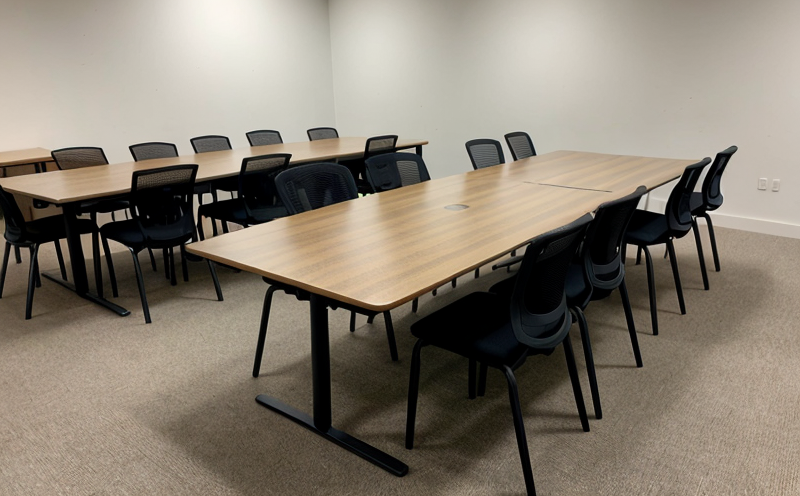BS EN 15372 Non Domestic Tables Safety Strength and Durability Testing
The British Standard (BS) and European Norm (EN) standard BS EN 15372:2014, titled “Safety, strength and durability of furniture for non-domestic use – Test methods”, provides a robust framework to ensure the safety, strength, and durability of tables and desks used in public spaces such as schools, offices, and restaurants. This standard is essential for manufacturers, quality managers, compliance officers, and R&D engineers involved with non-domestic furniture design and production.
The standard addresses key aspects including structural integrity, load-bearing capacity, stability under stress, resistance to impact, and wear and tear over time. Compliance with BS EN 15372 is not only a regulatory requirement but also ensures the safety of users in public spaces by preventing accidents or injuries caused by furniture failures.
Understanding the scope and requirements of this standard can help manufacturers optimize their design processes, ensuring that the products meet both international standards and customer expectations. For instance, the standard specifies test methods to evaluate the following:
- Static load tests
- Dynamic impact resistance tests
- Stability tests under static loads
- Mechanical durability tests (e.g., drawer pulls, castors)
- Wear and tear tests on finishings and joints
The testing process is both rigorous and methodical. Specimens are prepared according to the standard’s specifications, ensuring that they reflect real-world usage conditions as closely as possible. Load cells and strain gauges are used in static load tests to measure the structural integrity of tables under various weight distributions.
Dynamic impact resistance tests use drop weights or pendulums to assess how well a table can withstand impacts without collapsing or causing injury. Stability tests involve placing loads on one edge while evaluating whether the table remains stable and does not wobble excessively.
The mechanical durability of drawers, castors, and other moving parts is tested using specific cycles that simulate typical usage patterns in non-domestic environments. Wear and tear tests focus on the finishings and joints to ensure they remain intact under prolonged use.
Upon completion of these tests, a detailed report is generated, summarizing the results and any areas where improvements can be made. Compliance with BS EN 15372 ensures that manufacturers are meeting not only regulatory requirements but also enhancing their reputation for quality and safety in public spaces.
Why It Matters
The importance of compliance with BS EN 15372 Non Domestic Tables Safety Strength and Durability Testing cannot be overstated. Non-domestic furniture, especially tables and desks used in schools, offices, and public spaces like restaurants, is subject to a wide range of stresses that are not typically encountered in home settings.
These environments require furniture that can withstand the demands placed on them by multiple users throughout the day. For instance, classroom desks must support students while they work or sit for extended periods, resisting both physical and environmental stressors like spills, temperature changes, and varying loads.
Incorporating this standard into your product development process ensures that you are meeting international standards of quality and safety. This not only enhances the reputation of your brand but also minimizes the risk of accidents or injuries caused by furniture failures in public spaces.
Furthermore, compliance with BS EN 15372 can help reduce liability risks for manufacturers and facilities using this furniture. By demonstrating adherence to recognized standards, you provide evidence that due diligence has been taken to ensure product safety and quality.
Benefits
- Enhanced Safety: Ensures that tables meet strict safety requirements, reducing the risk of accidents or injuries in public spaces.
- Improved Quality Reputation: Compliance with international standards boosts brand reputation among consumers and stakeholders.
- Regulatory Compliance: Helps manufacturers stay compliant with relevant regulations, avoiding potential legal issues.
- Increased Market Access: Meeting global standards can open doors to new markets where compliance is required.
- Customer Satisfaction: Providing safer and more durable products increases customer satisfaction and loyalty.
- Competitive Advantage: Demonstrating commitment to quality through adherence to international standards can set your brand apart from competitors.
The benefits extend beyond just the manufacturing process. By ensuring that tables meet these stringent safety, strength, and durability requirements, manufacturers contribute to a safer environment for users in non-domestic settings.
Customer Impact and Satisfaction
- Increased User Confidence: Knowing that the furniture they use meets international standards can boost confidence and trust among customers.
- Prolonged Product Lifespan: Durability testing ensures that tables are built to last, which is especially important in high-use environments like schools or offices.
- Reduced Maintenance Costs: Stronger, more durable furniture requires less frequent maintenance and replacement, saving time and money for facilities managers.
- Better User Experience: Furniture that meets safety and durability standards provides a more comfortable and safer working environment, enhancing the overall user experience.
- Enhanced Brand Image: Customers are more likely to choose brands that demonstrate a commitment to quality and safety in their products.
The impact of meeting these standards is not just felt by users but also extends to facilities managers who can allocate resources more efficiently, knowing they have safe, reliable furniture. This contributes to overall satisfaction and loyalty, which are crucial for long-term relationships with clients.





